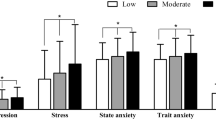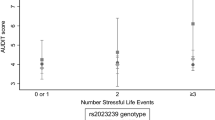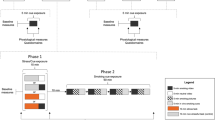Abstract
Cigarette smoking is a complex behavioral phenotype to which environmental, psychological and genetic factors contribute. The purpose of this study was to investigate these multifactorial effects with a specific focus on young women and on genes that encode serotonin (5-HT) receptors and the 5-HT transporter. A case–control sample of female Israeli college students provided comprehensive background data and details of cigarette smoking and completed a battery of psychological instruments. They were divided into smoking initiators (SI, n=242) or non-initiators (NI, n=148); SI were further subdivided into high (HND, n=127) and low nicotine-dependent smokers (LND, n=115) on the basis of their scores on the Fagerstrom Tolerance Questionnaire (FTQ). Single-nucleotide polymorphisms (SNPs) in five serotonin receptor genes (HTR1A, HTR1B, HTR2A, HTR2C and HTR6) and the 5-HT transporter-linked polymorphic region (5-HTTLPR) were genotyped. In a logistic regression model for SI (χ2=117.90, P=1.6 × 10−19, Nagelkerke R2=0.42), novelty seeking (odds ratio (OR)=1.134, P=0.00009) was a significant risk factor. A five SNP CACCC haplotype in HTR6 was a strong protective factor against SI (OR=0.26; P=0.007). The interaction of HTR6-C276T genotype and lifetime traumatic experience contributed strongly to the risk of SI (OR=13.88, P=0.0001). Specifically, subjects homozygous for the HTR6-C276T C allele showed significantly increased risk of SI if they had experienced trauma. Although significant (χ2=42.85, P=1.00 × 10−7), the best-fitting model for ND was less predictive than the model for SI (Nagelkerke R2=0.24). HTR1B-G861C GG genotype (OR=2.29, P=0.01) was a significant risk factor for HND. Further studies should consider the interactive contribution of life events and relevant gene variants to cigarette smoking and other complex behavioral traits.
This is a preview of subscription content, access via your institution
Access options
Subscribe to this journal
Receive 12 print issues and online access
$259.00 per year
only $21.58 per issue
Buy this article
- Purchase on Springer Link
- Instant access to full article PDF
Prices may be subject to local taxes which are calculated during checkout

Similar content being viewed by others
References
Department of Health and Human Services, Center for Disease Control. Morbid Mort Week Rep 2005; 54 (44): 1121–1124 http://www.cdc.gov/mmwr/preview/mmwrhtml/mm5444a2.htm.
Office for National Statistics General Household Survey for Data on Smoking Prevalence. 2005; http://www.statistics.gov.uk/cci/nugget.asp?id=921.
Israel Ministry of Health. Report on Smoking in Israel 2003–2004. Israel Ministry of Health, Jerusalem, 2004.
Israel Ministry of Health. Report on Smoking in Israel 2004–2005. Israel Ministry of Health: Jerusalem, 2005.
Furberg H, Sullivan PF, Maes H, Prescott CA, Lerman C, Bulik C et al. The types of regular cigarette smokers: a latent class analysis. Nicotine Tob Res 2005; 7: 351–360.
Stolerman IP, Jarvis MJ . The scientific case that nicotine is addictive. Psychopharmacology (Berl) 1995; 117: 2–10.
Barman SK, Pulkkinen L, Kaprio J, Rose RJ . Inattentiveness, parental smoking and adolescent smoking inititiation. Addiction 2004; 99: 1049–1061.
Tyc VL, Hadley W, Allen D, Ey S, Rai SN, Lensing S . Predictors of smoking intentions and smoking status among nonsmoking and smoking adolescents. Addict Behav 2004; 29: 1143–1147.
Peterson AV, Lerous BG, Bricker J, Kealey KA, Marek PM, Sarason IG et al. Nine-year prediction of adolescent smoking by number of smoking parents. Addict Behav 2005 Jun 28 (Epub ahead of print). doi:10.1016/j.addbeh.2005.06.003.
Harakeh Z, Scholte RH, deVries H, Engles RC . Parental rules and communication: their association with adolescent smoking. Addiction 2005; 100: 862–870.
Tilson EC, McBride CM, Lipkus IM, Catalono RF . Testing the interaction between parent–child relationship factor and parent smoking to predict youth smoking. J Adol Health 2004; 35: 182–189.
Wilkinson D, Abraham C . Constructing an integrated model of the antecedents of adolescent smoking. Br J Health Psychol 2004; 9: 315–333.
Harakeh Z, Scholte RH, Vermulst AA, de Vries H, Engels RC . Parental factors and adolescents' smoking behavior: an extension of the theory of planned behavior. Prev Med 2004; 39: 951–961.
Van Loon AJM, Tijhuis M, Surtees PG, Ormel J . Determinants of smoking status: cross-sectional data on smoking initiation and cessation. Eur J Public Health 2005; 15: 256–261.
Pomerleau CS, Pomerleau OF, Flessland KA, Basson SM . Relationship of tridimensional personality questionnaire scores and smoking variables in female and male smokers. J Subst Abuse 1992; 4: 143–154.
Kremer I, Bachner-Melman R, Reshef A, Broude L, Nemanov L, Gritsenko I et al. Association of the serotonin transporter gene with smoking behavior. Am J Psychiatry 2005; 162: 924–930.
Kendler KS, Neale MC, Sullivan P, Corey LA, Gardner CO et al. A population-based twin study in women of smoking initiation and nicotine dependence. Psychol Med 1999; 29: 299–308.
Goodwin R, Hamilton SP . Cigarette smoking and panic: the role of neuroticism. Am J Psychiatry 2002; 159: 1208–1213.
Kim YH . Korean adolescents' smoking behavior and its correlation with psychological variables. Addict Behav 2005; 30: 343–350.
Anda RF, Croft JB, Felitti VJ, Nordenberg D, Giles WH, Williamson DF et al. Adverse childhood experiences and smoking during adolescence and adulthood. JAMA 1999; 282: 1652–1658.
Nelson EC, Heath AC, Madden PAF, Cooper ML, Dinwiddie SH, Bucholz KK et al. Association between self-reported childhood sexual abuse and adverse psychosocial outcomes. Results from a twin study. Arch Gen Psychiatry 2002; 59: 139–145.
Nichols HB, Harlow BL . Childhood abuse and risk of smoking onset. J Epidemiol Commun Health 2004; 58: 402–406.
Lloyd DA, Taylor J . Lifetime cumulative adversity, mental health and the risk of becoming a smoker. Health 2006; 10: 95–112.
Fagerstrom KO . Measuring degree of physical dependence to tobacco smoking with reference to individuation of treatment. Addict Behav 1978; 3: 235–241.
Kardia SL, Pomerleau CS, Rozek LS, Marks JL . Association of parental smoking history with nicotine dependence, smoking rate, and psychological cofactors in adult smokers. Addict Behav 2003; 28: 1447–1452.
Madden PA, Madden F, Bucholz KK, Dinwiddie SH, Slutske WS, Bierut LJ et al. Nicotine withdrawal in women. Addiction 1997; 92: 889–902.
Niu T, Chen C, Ni J, Wang B, Fang Z, Shao H et al. Nicotine dependence and its familial aggregation in Chinese. Int J Epidemiol 2000; 29: 248–252.
Li MD, Cheng R, Ma JZ, Swan GE . A meta-analysis of estimated genetic and environmental effects on smoking behavior in male and female adult twins. Addiction 2003; 98: 23–31.
Sullivan PF, Kendler KS . The genetic epidemiology of smoking. Nicotine Tobacco Res 1999; 1 (Suppl. 2): S51–S57; discussion S69–S70.
Straub RE, Sullivan PF, Ma Y, Myakishev MV, Harris-Kerr C, Wormley B et al. Susceptibility genes for nicotine dependence: a genome scan and followup in an independent sample suggest that regions on chromosomes 2, 4, 10, 16, 17 and 18 merit further study. Mol Psychiatry 1999; 4: 129–144.
Gelernter J, Liu X, Hesselbrock V, Page GP, Goddard A, Zhang H . Results of a genomewide linkage scan: support for chromosomes 9 and 11 loci increasing risk for cigarette smoking. Am J Med Genet B Neuropsychiatr Genet 2004; 128: 94–101.
Arinami T, Ishiguro H, Onaivi ES . Polymorphisms in genes involved in neurotransmission in relation to smoking. Eur J Pharmacol 2000; 410: 215–226.
Greenbaum L, Kanyas K, Karni O, Merbl Y, Olender T, Horowitz A et al. Why do young women smoke? I. Direct and interactive effects of environment, psychological characteristics and nicotinic cholinergic receptor genes. Mol Psychiatry 2005 (Epub ahead of print); doi: 10.1038/sj.mp.4001774.
Anguelova M, Benkelfat C, Turecki G . A systematic review of association studies investigating genes coding for serotonin receptors and the serotonin transporter: I. Affective disorders. Mol Psychiatry 2003; 8: 574–591.
Anguelova M, Benkelfat C, Turecki G . A systematic review of association studies investigating genes coding for serotonin receptors and the serotonin transporter: II. Suicidal behavior. Mol Psychiatry 2003; 8: 646–653.
Gross C, Hen R . Genetic and environmental factors interact to influence anxiety. Neurotox Res 2004; 6: 493–501.
Ribeiro EB, Bettiker RL, Bogdanov M, Wurtman RJ . Effects of systemic nicotine on serotonin release in rat brain. Brain Res 1993; 621: 311–318.
Mihailescu S, Palomero-Rivero M, Meade-Huerta P, Maza-Flores A, Drucker-Colin R . Effects of nicotine and mecamylamine on rat dorsal raphe neurons. Eur J Pharmacol 1998; 360: 31–36.
Mihailescu S, Guzman-Marin R, Dominguez Mdel C, Drucker-Colin R . Mechanisms of nicotine actions on dorsal raphe serotoninergic neurons. Eur J Pharmacol 2002; 452: 77–82.
Hughes J, Stead L, Lancaster T . Antidepressants for smoking cessation. Cochrane Database Syst Rev 2004; 4: CD000031.
Hughes JR, Stead LF, Lancaster T . Nortriptyline for smoking cessation: a review. Nicotine Tob Res 2005; 7: 491–499.
Hoyer D, Hannon JP, Martin GR . Molecular, pharmacological and functional diversity of 5-HT receptors. Pharmacol Biochem Behav 2002; 71: 533–554.
Barnes NM, Sharp T . A review of central 5-HT receptors and their function. Neuropharmacology 1999; 38: 1083–1152.
Terayama H, Itoth M, Fukunishi I, Iwahashi K . The serotonin-2A receptor polymorphism and smoking behavior in Japan. Psychiatr Genet 2004; 14: 195–197.
Prado-Lima PA, Chatkin JM, Taufer M, Oliveira G, Silveira E, Neto CA et al. Polymorphism of 5HT2A serotonin receptor gene is implicated in smoking addiction. Am J Med Genet B Neuropsychiatr Genet 2004; 128: 90–93.
Sullivan PF, Jiang Y, Neale MC, Kendler KS, Straub RE . Association of the tryptophan hydroxylase gene with smoking initiation but not progression to nicotine dependence. Am J Med Genet 2001; 105: 479–484.
Lerman C, Caporaso NE, Bush A, Zheng YL, Audrain J, Main D et al. Tryptophan hydroxylase gene variant and smoking behavior. Am J Med Genet 2001; 105: 518–520.
Reuter M, Hennig J . Pleiotropic effect of the TPH A779C polymorphism on nicotine dependence and personality. Am J Med Genet B Neuropsychiatr Genet 2005; 134: 20–24.
Lerman C, Shields PG, Audrain J, Main D, Cobb B, Bouyd NR et al. The role of the serotonin transporter gene in cigarette smoking. Cancer Epidemiol Biomarker Prev 1999; 7: 253–255.
Ishikawa H, Ohtsuki T, Ishiguro H, Yamakawa-Kobayashi K, Endo K et al. Polymorphism and smoking among Japanese males. Cancer Epidemiol Biomarkers Prev 1999; 8: 831–833.
Hu S, Brody CL, Fisher C, Gunzerath L, Nelson ML, Sabol SZ et al. Interaction between the serotonin transporter gene and neuroticism in cigarette smoking behavior. Mol Psychiatry 2000; 5: 181–188.
Lerman C, Caporaso NE, Audrain J, Main D, Boyd NR, Shields PG . Interacting effects of the serotonin transporter gene and neuroticism in smoking practices and nicotine dependence. Mol Psychiatry 2000; 5: 189–192.
Gerra G, Garofano L, Zaimovic A, Moi G, Branchi B, Bussandri M et al. Association of the serotonin transporter promoter polymorphism with smoking behavior among adolescents. Am J Med Genet B Neuropsychiatr Genet 2005; 135: 73–78.
Derogatis LR . Brief Symptom Inventory (BSI): Administration, Scoring and Procedures Manual,, 3rd edn. National Computer Systems: Minneapolis, MN, 1993.
Garner DM, Garfinkel PE . The eating attitudes test: an index for the symptoms of anorexia nervosa. Psychol Med 1979; 9: 273–279.
Bartholomew K, Horowitz LM . Attachment styles among young adults: a test of a four-category model. J Person Social Psychol 1991; 61: 226–244.
Procidano ME, Heller K . Measures of perceived social support from friends and from family: three validation studies. Am J Comm Psych 1983; 11: 1–21.
Parker G, Tubling H, Brown LB . A parental bonding instrument. Br J Med Psych 1979; 52: 1–10.
Olson DH, Bell R, Portner J . Family Adaptability and Cohesion Evaluation Scales, FACES-II, Family Inventories Manual Life Innovations, Minneapolis, MN, 1992.
Cloninger CR, Przybeck TR, Svrakic DM . The tridimensional personality questionnaire: US normative data. Psychol Rep 1991; 69: 1047–1057.
Ebstein RP, Gritsenko I, Nemanov L, Frisch A, Osher Y, Belmaker RH . No association between the serotonin transporter gene regulatory region polymorphism and the Tridimensional Personality Questionnaire (TPQ) temperament of harm avoidance. Mol Psychiatry 1997; 2: 224–226.
Stephens M, Smith NJ, Donnelly P . A new statistical method for haplotype reconstruction from population data. Am J Hum Genet 2001; 68: 978–989.
Stephens M, Donnelly P . A comparison of Bayesian methods for haplotype reconstruction from population genotype data. Am J Hum Genet 2003; 73: 1162–1169.
Hosmer D, Lemeshow S . Applied Logistic Regression, 2nd edn. Wiley Interscience: New York, 2000.
Jaccard J . Interaction Effects in Logistic Regression. Sage: California, 2001.
Woolley ML, Marsden CA, Fone KC . 5-HT6 receptors. Curr Drug Targets CNS Neurol Disord 2004; 3: 59–79.
Lee SH, Lee KJ, Lee HJ, Ham BJ, Ryu SH, Lee MS . Association between the 5-HT6 receptor C267T polymorphism and response to antidepressant treatment in major depressive disorder. Psychiatry Clin Neurosci 2005; 59: 140–145.
Sari Y . Serotonin1B receptors: from protein to physiological function and behavior. Neurosci Biobehav Rev 2004; 28: 565–582.
Sanders AR, Duan J, Gejman PV . DNA variation and psychopharmacology of the human serotonin receptor 1B (HTR1B) gene. Pharmacogenomics 2002; 3: 745–762.
Segman RH, Heresco-Levy U, Finkel B, Goltser T, Shalem R, Schlafman M et al. Association between the serotonin 2A receptor gene and tardive dyskinesia in chronic schizophrenia. Mol Psychiatry 2001; 6: 225–229.
Albert PR, Lemonde S . 5-HT1A receptors, gene repression, and depression: guilt by association. Neuroscientist 2004; 10: 575–593.
Acknowledgements
Research described in this article was supported in part by Philip Morris USA Inc. and Philip Morris International. The project was initiated by the investigators and the sponsor had no role in its design, in the analysis and interpretation of the data or in the preparation of the paper. We thank Inge Gritsenko for excellent technical assistance.
Author information
Authors and Affiliations
Corresponding author
Additional information
Supplementary Information accompanies the paper on Molecular Psychiatry website (http://www.nature.com/mp)
Supplementary information
Rights and permissions
About this article
Cite this article
Lerer, E., Kanyas, K., Karni, O. et al. Why do young women smoke? II. Role of traumatic life experience, psychological characteristics and serotonergic genes. Mol Psychiatry 11, 771–781 (2006). https://doi.org/10.1038/sj.mp.4001855
Received:
Revised:
Accepted:
Published:
Issue Date:
DOI: https://doi.org/10.1038/sj.mp.4001855
Keywords
This article is cited by
-
Interaction between polygenic risk for cigarette use and environmental exposures in the Detroit neighborhood health study
Translational Psychiatry (2013)
-
Why do young women smoke? VI. A controlled study of nicotine effects on attention: pharmacogenetic interactions
The Pharmacogenomics Journal (2011)
-
Common and Unique Biological Pathways Associated with Smoking Initiation/Progression, Nicotine Dependence, and Smoking Cessation
Neuropsychopharmacology (2010)
-
HTR1B as a risk profile maker in psychiatric disorders: a review through motivation and memory
European Journal of Clinical Pharmacology (2010)
-
Differential contribution of genetic variation in multiple brain nicotinic cholinergic receptors to nicotine dependence: recent progress and emerging open questions
Molecular Psychiatry (2009)



